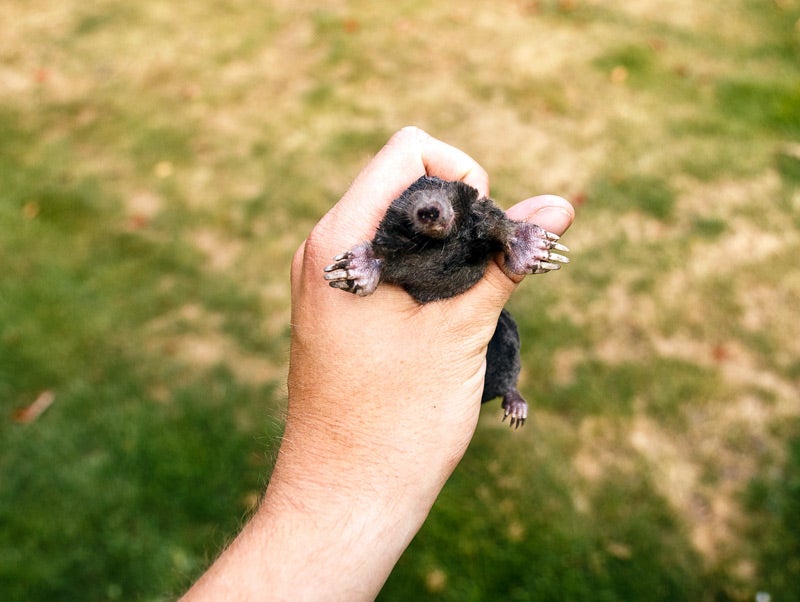How to ward off pesky squirrels!
Listen 00:52:58When fruits get ripening, Evil Squirrels get going! Mike McGrath, host of You Bet Your Garden, will discuss several ways to try and save your precious harvest from these long-tailed Servants of Satan! Plus answers to all your growing questions.
Question of the Week:
“I use four-foot high, 16-foot long cattle panels to create a huge tomato trellis, tying the vines to the panels as they grow up and then tossing them over to the other side when they reach the top. It provides strong support; and perhaps makes it too easy for Mr. Squirrel to pick the best tomatoes. Any ideas? Would it be wrong to hide in the garage and shoot squirrels?”
— “MJ” in Hampton, Virginia
Keeping evil squirrels out of your tomatoes and other fruits »
Highlights from show for May 30, 2015:
Gluten Meal
Barbara in Abington, PA recently bought corn gluten meal for her lawn to put down in the spring, but since she bought it, it hasn’t rained. She wants to know what she needs to do to get the most out of it in this recent dryness. Mike explains that corn gluten meal is a great fertilizer, rich in nitrogen, what your lawn wants, and poor in phosphorous, what your lawn doesn’t want. And when it’s applied at the right time, it can prevent weed seeds from germinating. The first window was in March, but it’s “still a fairly safe time to feed your lawn,” as it hasn’t gotten too hot yet. Now, if you have a cool-season lawn, a much more important time to feed your lawn is in early to mid-August, which will prevent a great deal more weeds. However, since Barbara has Zoysia grass, a warm-season grass, Mike assures that in her case, and in the case of anyone else with a Zoysia lawn, “this is the perfect time to feed it.”Additionally, since Zoysia lawns are so low maintenance, they don’t require much feed, and feeding doesn’t need to be coordinated with watering. “The only drawback is the brown color in the winter; other than that, they’re close to perfect.”
Salt Water Trouble
Following Hurricane Sandy in 2012, Joe in Brigantine, NJ was faced with a gardener’s nightmare! The year after the storm, most of his annuals, including rhododendron and holly, died off. When the storm came in, his property was underwater for quite some time, so he wants to know if that salt water could have killed them. Since then, he has flushed the soil with fresh water quite a few times, so he wants to know if there was anything more he could have done to save them. Mike explains that it would have been better to saturate the lawn with fresh water immediately after the storm, and that since the storm hit in the fall, and they were just starting to go dormant, many more of them could have been saved. But he commends Joe for his efforts, because had Joe not watered them so early in the spring, he would have lost them all. Mike says that the best thing to do going forward is to avoid chemical fertilizers, which are salts, and put compost on the surface., which will help retain water and feed the plants gently. He also explains that a more proactive approach, to prevent this kind of thing from happening again, would be to raise those raised beds higher. “In your region, where this has happened and could happen again, everyone should be planting high, in the highest possible sense.”
Carpenter Bees
Ashley from IN is the director of a preschool, and she has carpenter bees living in the wooden playset out on their playground. The bees, while harmless, are scaring the little ones, keeping them away from the play equipment. Mike replies that “even though they’re scared now, they will never forget that these big bees didn’t harm them.” In fact, this lesson is true of all native bees, as the only bee-like creatures that sting people are wasps and hornets, as well as the European honey bee. Mike also explains that carpenter bees are not too fond of Almond oil, which is very inexpensive if bought in bulk. Carpenter bees also avoid any painted wood, so repainting the equipment is also an effective means of control. However, these bees might be hard to get rid of, as they may have already laid their eggs in the playset. Then, once the bees are gone, build little bee houses with blocks of cheap pine, and drill holes in them, and then hang those blocks in unobtrusive places. Mike and Ashley both agree that as long as they’re there, “the bees could be a great teaching experience.”
Kid’s Garden
John in Bethlehem, PA is looking to start a vegetable garden for his three-year-old granddaughter and wants to know Mike’s recommendations for what sort of soil to use. Mike says that the best soil would be fifty-fifty leaf compost with rich, black, screened topsoil. Mike also likes to use pearlite, a natural popped volcanic glass that will lighten the soil. However, he does not recommend this to gardeners living in a dry climate, like in California or Arizona, as they want to do as much as they can to keep the moisture in the soil. John is also planning to begin composting in earnest, and wants to know if he should compost black walnut leaves. Mike says that this is not advised, as all parts of the black walnut tree contain a compound known as Juglone. However, if we’re dealing with only one black walnut tree amidst several other trees, Mike says not to worry, as the concentration is too low to worry about. But if there is a section that’s just black walnut trees, then leave those leaves on the ground.”
Getting Rid of Moles
Chris in NJ has moles, and wants to know the best way to get rid of them! Now, moles are absolute carnivores, eating mostly larvae and other bugs, and are not to be confused with voles, which are carnivores. They love to eat plant bulbs and roots and all of those other things your plants need to survive. Mike advises not to use poison gummy worms to get rid of moles, as they’ll generally not eat the worms. In fact, these poisoned gummy snacks pose a greater threat to small children and dogs than they do to any mole! “These are very dangerous, they should not be sold, and it’s foolish to use them.” Mike instead suggests using castor oil. Simply spread it around the lawn where the moles have been tunneling. As it rains, the smell of the castor oil permeates the subsoil, and since the moles don’t like that smell, they’ll get outta your lawn as quick as they can. If castor oil doesn’t work, another good poison-free alternative is a product called Mole Zap. This method does kill the moles, as it suffocates them down in their tunnels, displacing their oxygen and replacing it with CO2.”
Variety In the Garden
Angel in Oklahoma City, OK is curious about what sort of things she should plant in her garden to add some color and variety. Mike notes that Angel has some tough gardening conditions down in Oklahoma, with the “hellish”winds; hot, dry summers; and poor, alkaline soil. Mike recommends peppers and eggplants, which are nice, edible, ornamental plants. Specifically, he recommends asian varieties of eggplant, as they come in myriad shapes and colors, and hot peppers, which have great ornamental varieties that grow really well in Angel’s climate. Mike also notes that it’s a little late in the season for planting, so it would be ideal to go to the local Garden Center, where you can find these plants already growing and ready to be transplanted. Mike would also like to remind everyone that “’Ornamental’ just means it looks pretty too, the eggplants and the peppers are perfectly good to eat.””
WHYY is your source for fact-based, in-depth journalism and information. As a nonprofit organization, we rely on financial support from readers like you. Please give today.



